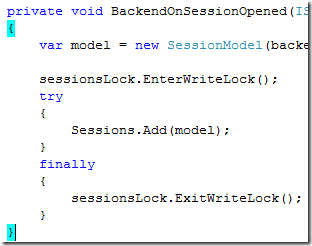I am getting some strange perf numbers from MSMQ, and I can’t quite figure out what is going on here.
The scenario is simple, I have a process reading from queue 1 and writing to queue 2. But performance isn’t anywhere near where I think it should be.
In my test scenario, I have queue 1 filled with 10,000 messages, each about 1.5 Kb in size. My test code does a no op move between the queues. Both queues are transactional.
Here is the code:
private static void CopyData()
{
var q1 = new MessageQueue(@".\private$\test_queue1");
var q2 = new MessageQueue(@".\private$\test_queue2");
q2.Purge();
var sp = Stopwatch.StartNew();
while (true)
{
using (var msmqTx = new MessageQueueTransaction())
{
msmqTx.Begin();
Message message;
try
{
message = q1.Receive(TimeSpan.FromMilliseconds(0), msmqTx);
}
catch (MessageQueueException e)
{
Console.WriteLine(e);
break;
}
q2.Send(message, msmqTx);
msmqTx.Commit();
}
}
Console.WriteLine("{0:#,#}", sp.ElapsedMilliseconds);
}
Using this code, it takes 236.8 seconds to move 10,000 messages. If I use System.Transactions, instead of MSMQ’s internal transactions, I get comparable speeds.
Just to give you an idea, this is about 40 messages a second, this number is ridiculously low.
Changing the code so each operation is a separate transaction, like this:
private static void CopyData()
{
var q1 = new MessageQueue(@".\private$\test_queue1");
var q2 = new MessageQueue(@".\private$\test_queue2");
q2.Purge();
var sp = Stopwatch.StartNew();
while (true)
{
Message message;
try
{
message = q1.Receive(TimeSpan.FromMilliseconds(0), MessageQueueTransactionType.Single);
}
catch (MessageQueueException e)
{
Console.WriteLine(e);
break;
}
q2.Send(message, MessageQueueTransactionType.Single);
}
Console.WriteLine("{0:#,#}", sp.ElapsedMilliseconds);
}
Means that it takes 16.3 seconds, or about 600 messages per second, which is far closer to what I would expect.
This is on a quad core machine 8 GB RAM (4 GB free), so I don’t think that it is the machine that is causing the problem. I can see similar results on other machines as well.
Am I missing something? Is there something in my code that is wrong?













